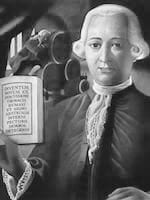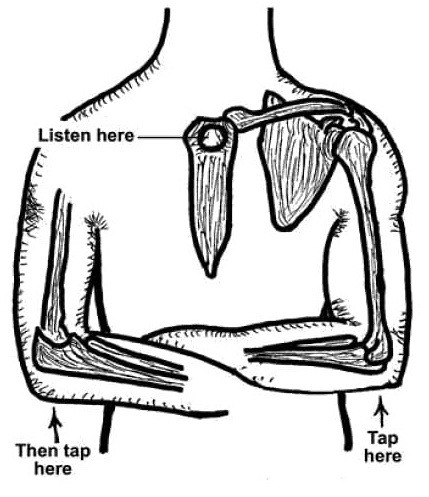Leopold Auenbrugger

Josef Leopold Auenbrugger von Auenbrugg (1722-1809) was an Austrian Physician
Credited with describing the effectiveness of chest percussion in the diagnosis of cardiac and respiratory disease.
Auenbrugger described camphor-induced seizures as a remedy for manic psychosis and suicidal thought.
Eponyms: Auenbrugger Sign I and II in cases of extensive pericardial effusion and Auenbrugger Osteophony/Bone Sign (more commonly Heuter sign)
Biography
- Born in Graz, Austria on 19th November 1722
- 1752 – Physician at the Spanish Military Hospital, Vienna
- 1754 – Defined and described ‘percussion‘ of the chest to define pleural effusions.
- 1779 – Wrote the libretto to Antonio Salieri’s three-act opera, The Chimney Sweep (‘Der Rauchfangkehrer’), first performed in the Burgtheater in Vienna in April 1781
- 1780 – Haydn composed the six Auenbrugger keyboard Sonatas for the Auenbrugger’s talented musical daughters (Marianna and Caterina) in 1780
- 1783 – Knighted for services to medicine by Emporer Joseph II
- 1790 – Physician to Wolfgang Amadeus Mozart, Vienna
- Died in Vienna on May 18, 1809
Medical Eponyms
Auenbrugger Sign (1761)
Dullness to percussion in Traube’s space associated with large pericardial effusion and descent of the left lobe of the liver
I have observed the following specific signs of the dropsy of the pericardium: The sound in the cardiac region, which I have already stated (III. 2. 3.) to be naturally more obscure than in the other parts of the chest, is now as completely deadened as if the percussion were applied to a fleshy limb.
Auenbrugger XLVI. Signs of Hydropericardium. 1761
Auenbrugger sign II (1761)
The bulging of the epigastrium (epigastric region) in patients with large pericardial effusion.
A swelling is perceived in the precordia, which can readily be distinguished, by its superior resistance, from the stomach distended by flatus.
Auenbrugger XLVI. Signs of Hydropericardium. 1761
Auenbrugger Bone Sign (Heuter sign)
Used to define the presence of upper limb fracture or dislocation via osteophony. Each olecranon is tapped whilst listening over the manubrium with the bell of the stethoscope. Intact bone gives a bright, crisp tapping sound to percussion with equal sound transmission to each side. If osteophony reveals a muffled or distant quality to the sound, this suggests a humeral fracture or glenohumeral dislocation.

Key Medical Attributions
Chest percussion
Described chest percussion to diagnose chest conditions. The son of an innkeeper, Auenbrugger is said to have tapped wine barrels in his father’s cellar as a boy to find out how full they were.
Auenbrugger validated his clinical observations on the use of diagnostic percussion by comparing clinical assessments with post-mortem findings and injecting fluid into the pleural cavity of cadavers to demonstrate that percussion could accurately define the physical limits of any fluid present.
I have not been unconscious of the dangers I must encounter, since it has always been the fate of those who have illustrated or improved the arts and sciences by their discovery, to be beset by envy, malice, hatred, detraction, and calumny.
Auenbrugger 1807
Unfortunately his work was largely unheralded at the time. His teacher (Van Swieten) in 1764 and 1772 major treatises on ‘pulmonary chills and chest water’ failed to mention Auenbrugger. Similarly De Haen, who was the head of the medical clinic in Vienna from 1754-1776 makes no comment on percussion in “Ratio Medendi In Nosocomio Practico Vol I to VIII” ironically complaining “how dark and difficult is the diagnosis of the thoracic water, the pleuritic and pericardian exudates.”
It was not until a French republication by Jean-Nicolas Corvisart des Marest (1755-1821), personal physician to Napoleon, appeared in 1808 that the diagnostic method gained worldwide acceptance. Corvisart taught the method of percussion to his students and in 1808 translated and published the book with annotations a year before Auenbrugger’s death
Controversies
Italian physician Giovanni Maria Lances (1654-1720), first described percussion of the chest bone in the diagnosis of consumption (tuberculosis)
Major Publications
- Auenbrugger L. Inventum Novum ex percussione thoracis humani ut signo abstrusos interni pectoris morbos detegendi. (Discovered a new signal from a blow to the chest of the human heart to discover hidden internal illness). 1761
- Auenbrugger L. Von der stillen Wuth oder dem Triebe zum Selbstmorde als einer wirklichen Krankheit, mit Original-Beobachtungen und Anmerkungen. (From silent rage or impulse to suicide as a real disease). 1763 .
- Auenbrugger L. Experimentum nascens de remedio specifico sub signo specifico in mania virorum. 1763
- Auenbrugger L. Nouvelle méthode pour reconnaitre les maladies internes de la poitrine par la percussion de cette cavité. 1770 [Translation and republication by Corvisart des Marets JN in 1808].
References
Biography
- Dock G. Leopold Auenbrugger and the history of percussion. 1898.
Eponymous terms
- Corvisart JN. Nouvelles méthodes pour reconnaître les maladies internes de la poitrine par la percussion de cette cavité, par Auenbrugger. Paris, Migneret, 1808.
- Forbes J. Avenbrugger’s treatise on percussion of the chest. In: Original cases with dissections and observations illustrating the use of the stethoscope and percussion in the diagnosis of diseases of the chest. 1824: 3-62
- Clar. Leopold Auenbrugger, der Erfinder der Percussion des Brustkorbes [Leopold Auenbrugger, the inventor of the percussion of the chest] 1867
- Balfour GW. On the evolution of cardiac diagnosis from Harvey’s days till now. Edinburgh Medical Journal 1887; 32(2): 1065.
- Walsh JJ. Auenbrugger, The inventor of physical diagnosis. In: Makers of modern medicine. 1907: 55-85
- Willius FA, Keys TE. Joseph Leopold Auenbrugger. In: Classics of Cardiology Volume One. New York. 1941: 191-192.
- Juhn B. Auenbrugger’s sign. Wiener Medizinische Wochenschrift. 1961; 111: 259.
- Simth JJ. The Inventum Novum of Joseph Leopold Auenbrugger. Bulletin of the New York Academy of Medicine. 1962; 38(10): 691–701
- Bedford DE. Auenbrugger’s contribution to cardiology – History of percussion of the heart. Br Heart J. 1971; 33(6): 817–821.
- Lachmund J. Between Scrutiny and Treatment: Physical Diagnosis and the Restructuring of 19th Century Medical Practice Sociology of Health and Illness 1998; 20(6): 779-801
- Pearce JM. Leopold Auenbrugger: camphor-induced epilepsy – remedy for manic psychosis. Eur Neurol. 2008;59(1-2):105-107.
- White FA. Physical Signs in Medicine and Surgery 2009: 317-331
- Ye F et al. Physical Examination Signs of Inspection and Medical Eponyms in Pericarditis Part I: 1761 to 1852. Erclyes Med J 2019; 41(2): 223–229
[cite]
Derry Girl. Emergency Medicine RMO at Sir Charles Gairdner Hospital, Perth. University of Nottingham Graduate BMBS BMedSci. Interested in Respiratory Medicine, Intensive Care and Medical Education.


Currently debating the reliability of percussion in the context of a respiratory examination for MSc ACP. Thank you for this brilliant summary!